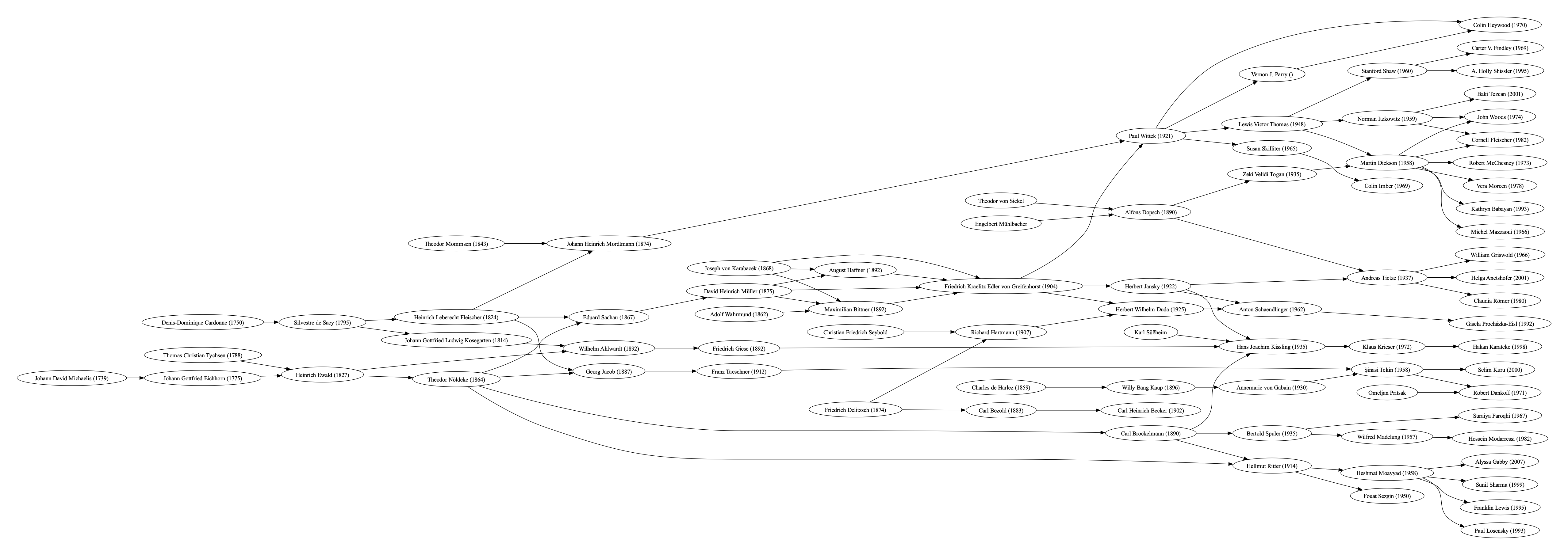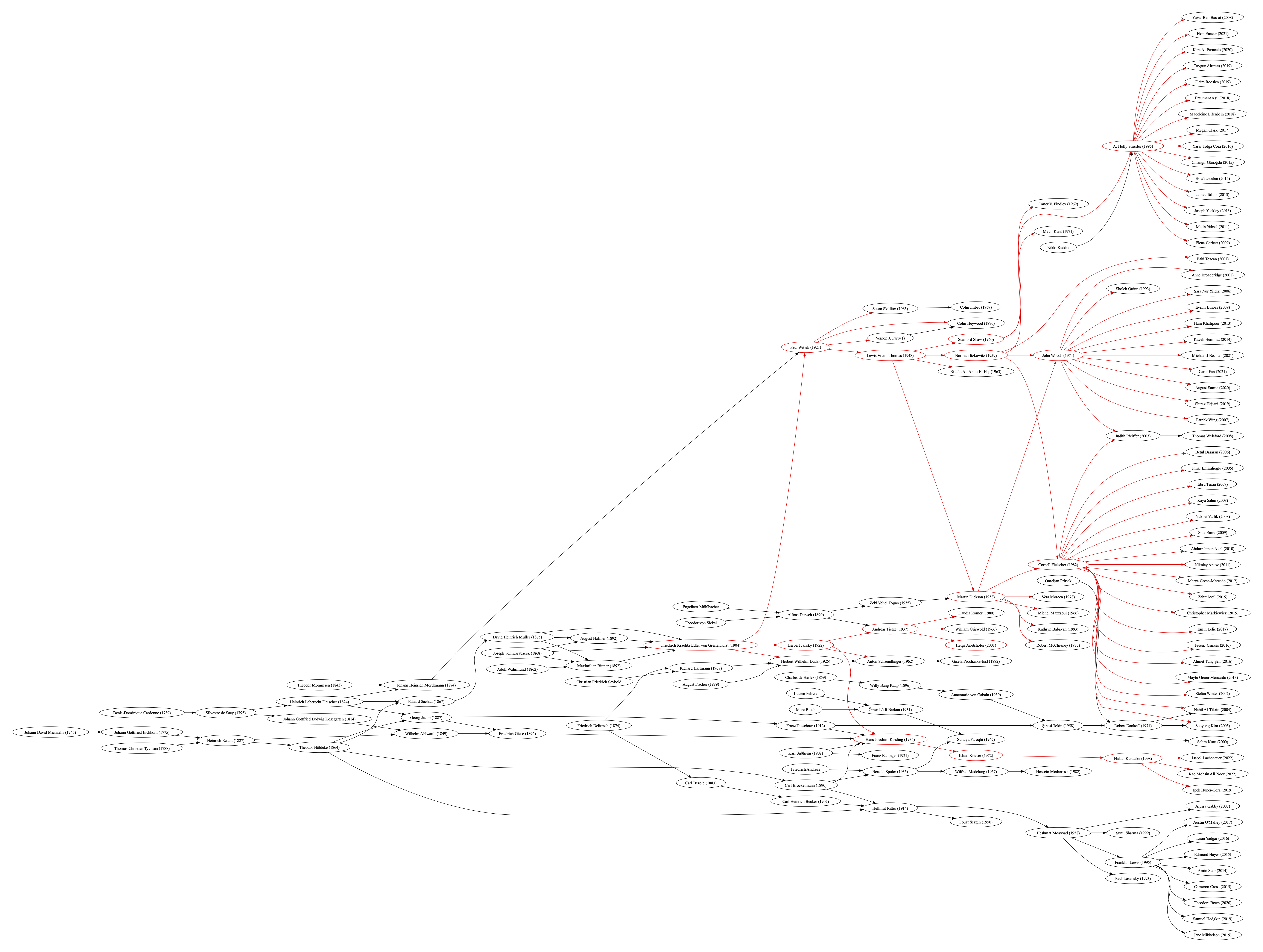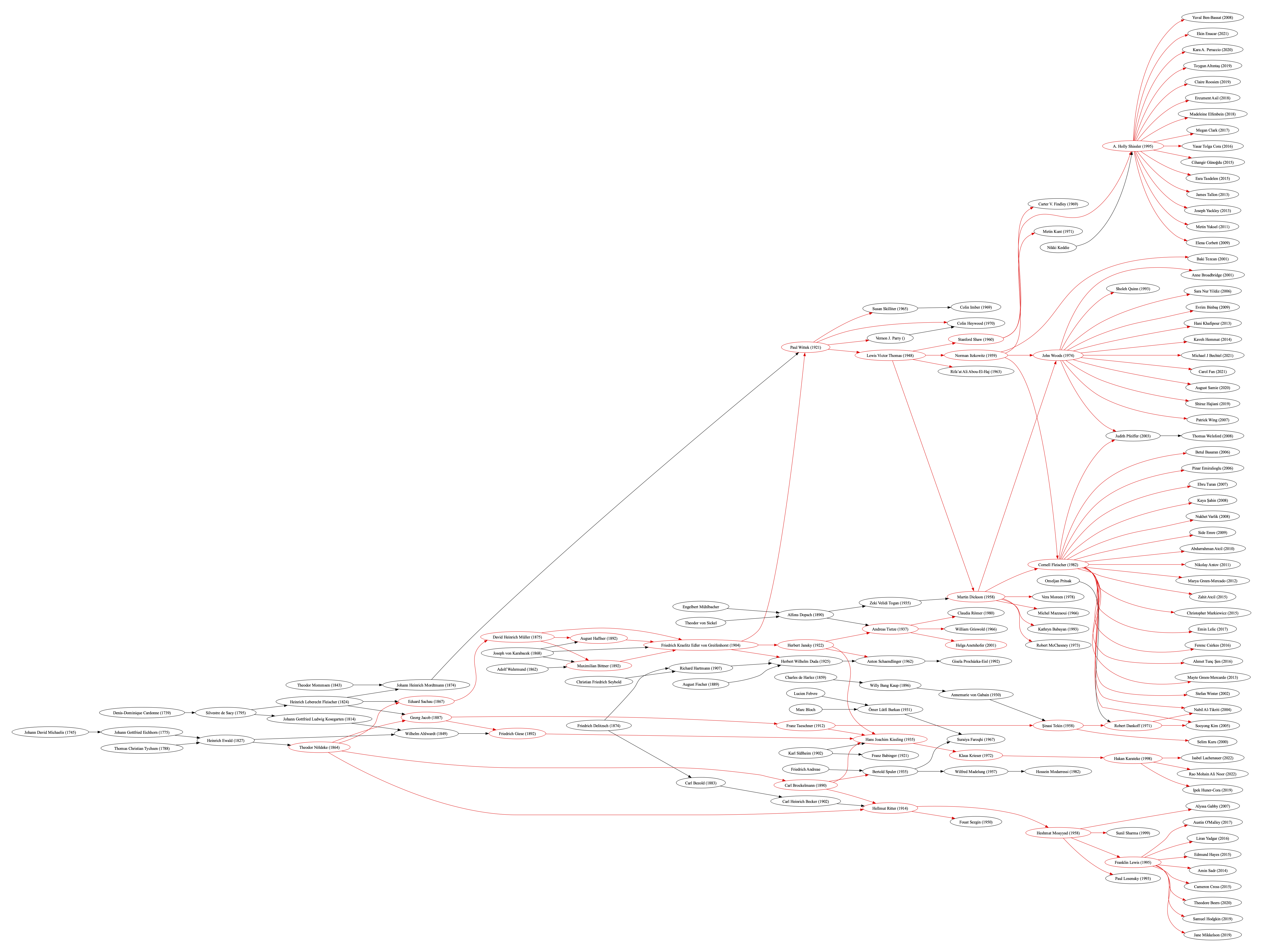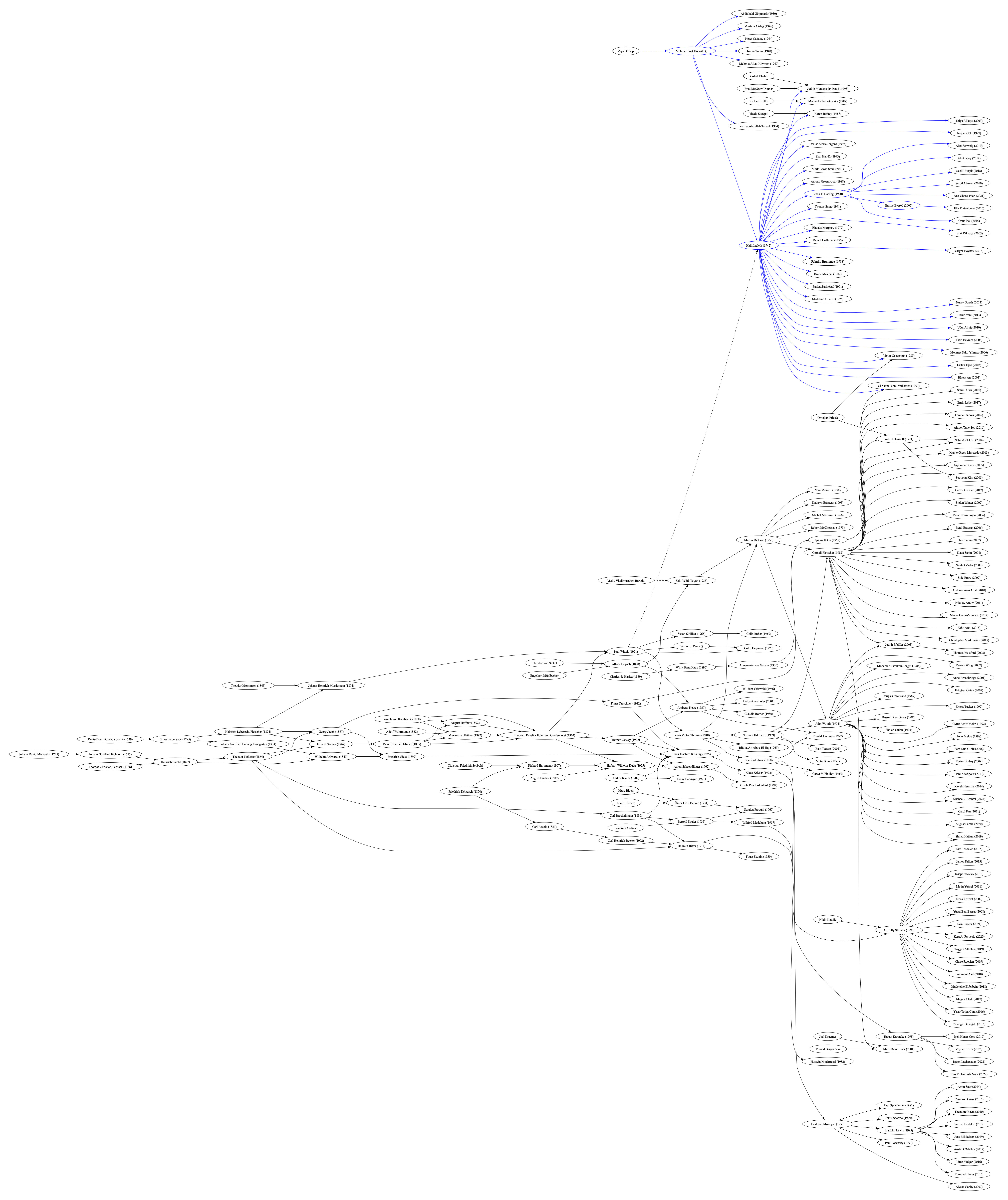A NELC Silsile
Inspired by the now defunct Modern Tabaqat Wikia and the spiritual geologies (silsiles) of Sufi tarikats I have attempted to create a visual representation of academic lineages in Middle Eastern and particularly Ottoman studies.A Note on Methodology
The basis of the data presented here was scraped from the Modern Tabaqat Wikia and supplemented with information drawn from the University of Chicago's NELC Department website and my own research into the Ottomanists at one time affiliated with it. It therefore contains an undeniable bias towards individuals educated or working in Euro-American academic institutions, especially UChicago, and towards Ottoman historians. While I've done my best to correct mistakes introduced when scraping the html undoubtedly some persist, please excuse any errors.For the sake of visual clarity, for students graduating in the last five (or so) decades, where a good deal of information is available online or via ProQuest, links are mostly shown between an advisee and those individuals identified as their primary PhD advisor(s). For earlier advisees I have taken a laxer approach to intellectual genealogy including any individuals identified as important educators in their lives whether by festschrifts or biographical articles.
All this said, I think a lot of interesting and surprising connections
— and perhaps even intellectual debts or affinities — are revealed by looking at a visual representation of these relationships. The full visualization of the data is a bit unwieldy, so I focus below on a few of the more interesting academic lineages related to UChicago. However, the full silsile is available in a word searchable pdf.
Results
How far back can we go? (Images are scrollable and open in a new tab when clicked)
We can trace back the greater portion of the recent generation of UChicago NELC faculty working on Ottoman and Iranian history and literature to two 18th century individuals. The first is Johann David Michaelis (1717-1791) a biblical scholar and teacher of Semitic philology who completed his doctorate in 1739 at the University of Halle before becoming a professor at the University of Göttingen. While Michaelis appears to have studied Arabic, there is little to link him to an enduring tradition of scholarship on the Ottoman Empire.
The other parent of this particular lineage, Denis Dominique Cardonne (1721-1783), is far more promising in this regard. Although he lacked formal academic training, he was one of the "jeunes de langue," taken to Istanbul at the age of nine to train in Turkish and Persian in order to act as a dragoman for the French embassy. He eventually returned to Paris where he became a chair of Ottoman Turkish and Persian at the Collège royal. Whether it was Cardonne himself or his one-time assistant Étienne Le Grand who trained the famous Orientalist Silvestre de Sacy in Turkish is unclear, but from this point on the intellectual lineage, through a web of Germanic scholarly institutions, is clearer and an interest in the texts and histories of the Islamic world a consistent theme. While the dominance of German philologists and historians in this lineage is unsurprising, given that at least one current professor received their training in Germany, that they share common "academic ancestors" with a wide variety of Ottomanists working on both sides of the Atlantic is rather interesting — to say nothing of the transatlantic reach of their students, which I have excluded from this visualization. (Note: To simplify the visualization I have also removed the branches that cannot be traced back before 1900, they are included below.)
Are we all Karelitzians?
Some academic lineages are more well known. In a recent piece for the journal Kadim in the wake of the untimely passing of Prof. Cornell Fleischer, Emeritus Professor John Woods recalled the connection between their shared advisor Martin Dickson and the famed historian, Turkologist, and Bashkir revolutionary Zeki Velidi Togan who came to hold the important Chair of Turkish History at Istanbul University. Looking deeper some interesting, and often unremarked, patterns begin to emerge. For example, Togan, who completed his PhD at the University of Vienna in the 1930s, opted to write his dissertations under the direction of Alfons Dopsch a social and economic historian of medieval Europe. Curiously, Dopsch was also the advisor of famous Turkologist Andreas Tietze. As best I can tell, Tietze's decision to work with Dopsch has generally been attributed to the fact that his interest in Turkology was still emerging during this period of his education. However, given that he shared an advisor with Togan and he later complained about Turkish language education in Vienna perhaps his decision was more purposeful than previously thought (see Anetshofer, "'Long live Ottoman studies': Andreas Tietze’yi (1914–2003) Hatırlarken," 317).
Looking for common academic forefathers brings us to another surprising conjunction, almost all of UChicago's recent Ottoman and Turkic historians can trace their lineage back to a single individual at the start of the 20th century, the University of Vienna's Friedrich Kraelitz Edler von Greifenhorst. Kraelitz published a number of Ottoman documents from the Ragusan archive and launched the study of Ottoman diplomatics before turning to focus on Mongolian and Tatar. He is perhaps best known as the mentor of Paul Wittek, the extraordinarily influential historian of the early Ottoman state and proponent of the Ghazi thesis. His scholarly influence is traced in the above image in red.
A shared Perso-Ottoman lineage
If we are willing to look slightly further back we find Theodor Nöldeke who stands as a common ancestor for all of the department's recent faculty working in the fields of Persian and Ottoman studies. Nöldeke was a German semiticist also noted for his study of Persian history who spent much of his career at the University of Strasbourg.
Köprülü/İnalcık Tree
For nearly a decade and a half UChicago NELC was also home to one of the most widely acclaimed Ottoman historians of the 20th century, Halil İnalcık. He graduated a generation of Ottoman historians serving in America and Great Britain before returning to Turkey to continue to tutor students at Bilkent University. His connection to the wider UChicago Perso-Ottoman tree identified above is more tangential, as he studied with Wittek in London only after completing his dissertation under Mehmet Fuat Köprülü at the University of Ankara. His influence on Ottoman studies, however, is indisputable, as was that of his mentor Köprülü, so I have highlighted their contribution in the NELC genealogy in blue. There are a number of other informal intellectual debts (like that between İnalcık and Wittek) throughout the tree, which I also represent with dashed lines.
The Full Silsile
This final tree attempts to incorporate all the faculty from various universities that are represented in the data. It is best viewed as a pdf, which has the advantage of being word searchable. At scale the genealogies become unwieldy, but with additional information on more distant ancestors they can offer interesting insights into the discipline of Middle Eastern studies. I have added color to those nodes of the tree with overlapping edges to make it easier to follow.




